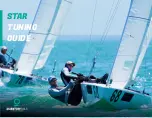
Section C
Page 3
Horizon & Sundowner
Owners Manual
06/00
Buoys are red or green floating ATONS. If lighted, they
have either red or green lights. Unlighted green buoys,
called cans, look like cylinders. Unlighted red nun buoys
have a cone shaped top with their points cut off. Do
not pass too close to a buoy. You may foul the propel-
ler in its chain.
NOTICE
Buoys are anchored floating objects and may
not always be in exactly the same position.
Daymarks are red or green boards with numbers. They
are on posts or groups of pilings tied together and called
dolphins. Daymarks and their supports are daybeacons.
Daybeacons may or may not have lights. If a red or
green daybeacon has a light, it is the same color as
the marker-red or green. Red daymarks are triangular
and have even numbers. Green daymarks are square
and have odd numbers.
Red, Right, Returning is a basic rule to assist you in
using lateral markers. When you are returning from
seaward , keep red markers on the starboard (right)
side when you pass them. Keep green markers to the
port side.
Returning from seaward is very clear if you have been
on the ocean. You are returning to port. By agree-
ment, going upstream on a navigational river is return-
ing from seaward. The outlet ends of the Great Lakes
are also the seaward ends. Traveling from a large body
of water to a smaller one is considered returning from
seaward.
C. Safe Water Markers
Safe water markers have vertical red and white stripes
and mark the center of navigable channels and fair-
ways. Safe water markers included both lighted and
unlighted buoys and daymarks. If a marker is lighted,
the light is white and flashes the letter A is Morse Code.
Preferred Channel markers have horizontal red and
green bands. If lighted, the color of the light is the same
as the top of the band. They show the preferred chan-
nel for you to use at a junction point. Be sure to notice
the color of the top of the band, and treat it as any other
marker you would of that color. If the band is red and
you are returning from seaward, keep the marker to
the right.
Most lights on markers flash on and off. Others such
as lights on aids with no lateral significance are fixed.
hazardous situations. Use whistle blasts early enough
to be noticed and understood by other boaters.
It is customary for the privileged boat to signal first and
the yielding boat to return the same signal to acknowl-
edge she understands and will comply. Use the dan-
ger signal (five or more short and rapid blasts) if intent
is not clear. A short blast is one or two seconds long. A
long blast is 4 to 6 seconds long. The Navigational
Aids Chart at the end of this section lists the meanings
of the various whistle signals.
C - 2 NAVIGATIONAL AIDS
Aids to navigation (ATONS) help you to travel safely on
the water. They help you get from one place to another
and are most helpful if you have a nautical chart. A
navigational aids chart is at the end of this section.
NEVER tie your vessel to an ATON. It is illegal
because it blocks the ATON from view of other
boaters. Decreased visibility can contribute to
a serious accident which may result in prop-
erty damage, personal injury, or death.
There are two ATON systems. The system used on
federal waters is known as the International Associa-
tion of Lighthouse Authorities System B (IALA-B). The
Coast Guard maintains this system. The second sys-
tem is the Uniform State Waterway Marking System
(USWMS). This system is maintained by state authori-
ties.
A. International Association of Lighthouse
Authorities System B (IALA-B)
IALA-B uses four types of ATONS. This section dis-
cusses the two most common markers: lateral mark-
ers and safe water markers. Other federal markers
include special markers and isolated danger markers.
The Navigational Aids Chart at the end of this section
shows these aids.
B. Lateral Markers
Lateral markers indicate the sides of navigable chan-
nels. They consist of lighted can or nun buoys and
daymarks. Each has a number and is either red or
green. The numbers on the green markers are odd.
Red markers have even numbers.
Содержание Horizon 210
Страница 1: ......
Страница 40: ...Section B Page 13 Horizon Sundowner Owner s Manual 06 00 Figure B15 Skiing Signals ...
Страница 88: ...Section J Page 7 Horizon Sundowner Owner s Manual 06 00 Figure J9 General Water System Diagram WATER SYSTEM ...
Страница 146: ...Fuel Log Page 1 Horizon Sundowner Owner s Manual 06 00 FUEL LOG DATE HOURS RUN FUEL GAL RANGE MILES RPM MPH GPH ...
Страница 147: ...Fuel Log Page 2 Horizon Sundowner Owner s Manual 06 00 FUEL LOG DATE HOURS RUN FUEL GAL RANGE MILES RPM MPH GPH ...
Страница 148: ...Fuel Log Page 3 Horizon Sundowner Owner s Manual 06 00 FUEL LOG DATE HOURS RUN FUEL GAL RANGE MILES RPM MPH GPH ...
Страница 149: ...Service Log Page 1 Horizon Sundowner Owner s Manual 06 00 SERVICE LOG DATE HOURS MAINTENANCE PERFORMED ...
Страница 150: ...Service Log Page 2 Horizon Sundowner Owner s Manual 06 00 SERVICE LOG DATE HOURS MAINTENANCE PERFORMED ...
Страница 151: ...Service Log Page 3 Horizon Sundowner Owner s Manual 06 00 SERVICE LOG DATE HOURS MAINTENANCE PERFORMED ...
Страница 157: ...Horizon Sundowner Owner s Manual 06 00 280 HORIZON 285 SUNDOWNER AC CABIN PANEL ASSEMBLY Electrical Schematics Page 5 ...
Страница 158: ...Horizon Sundowner Owner s Manual 06 00 280 HORIZON 285 SUNDOWNER TOILET PANEL ASSEMBLY Electrical Schematics Page 6 ...
Страница 159: ...Four Winns L L C Part 090 2587 ...
















































